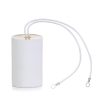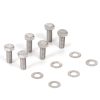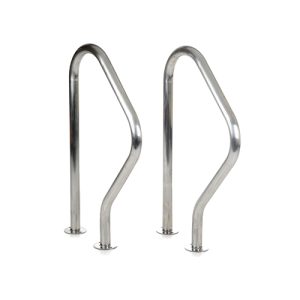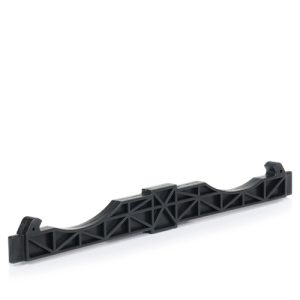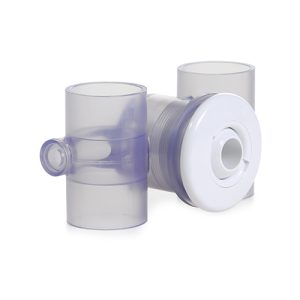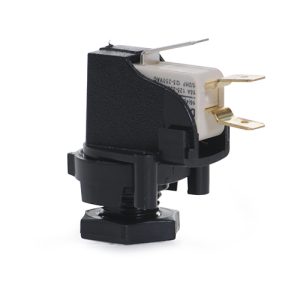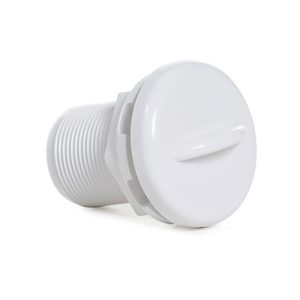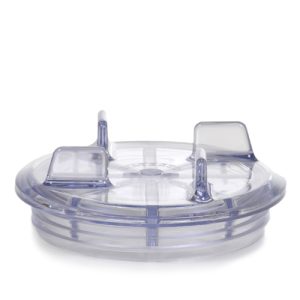Aquamite 0.33hp / 0.50hp / Supastream 0.50hp Pump Capacitor (to suit 63 Frame Motor) 12.5MF
£69.13 Inc VAT
1 in stock
Aquamite 0.33hp / 0.50hp / Supastream 0.50hp Pump Capacitor (63 Frame Motor) 12.5MF
Essential Starting Component for Single-Phase Motors
As a retailer of pool and spa parts, I stock this replacement run capacitor for Aquamite 0.33hp, 0.50hp, and Supastream 0.50hp pumps equipped with 63 frame motors. This critical electrical component enables the motor to start and run efficiently—without a functioning capacitor, your pump simply won’t operate.
What is a Motor Capacitor?
A capacitor is an electrical component that stores and releases electrical energy to help single-phase motors start and run. The 12.5MF (microfarad) rating indicates the capacitor’s storage capacity, specifically matched to the electrical requirements of 0.33hp and 0.50hp motors used in these pump models.
The capacitor connects to the motor’s start winding, creating a phase shift in the electrical current that generates the rotating magnetic field necessary for motor operation. Without this phase shift, single-phase motors cannot produce the torque needed to start rotating under load.
Housed in a cylindrical metal or plastic case, the capacitor typically mounts on the exterior of the motor housing where it’s accessible for testing and replacement. Two or more wire terminals protrude from the top for electrical connections.
How Capacitors Enable Motor Operation
Single-phase AC motors face a unique challenge—unlike three-phase motors that have inherently rotating magnetic fields, single-phase motors need assistance to create rotation. The capacitor solves this problem by temporarily storing electrical charge and releasing it at a specific time during the AC cycle.
This stored energy flows through the start winding, creating a secondary magnetic field that’s out of phase with the main winding’s field. These two fields interact to produce a rotating magnetic field that gets the rotor spinning. Once running, the motor can continue operating even if the capacitor fails, though efficiency drops and the motor may overheat.
In run capacitor applications (like most pool pump motors), the capacitor remains in the circuit during operation, continuously improving motor efficiency and power factor. This reduces electricity consumption and keeps the motor running cooler and quieter.
Signs Your Capacitor Needs Replacement
The most obvious symptom is a motor that hums but won’t start. You’ll hear the electrical hum indicating power is reaching the motor, but the shaft doesn’t rotate. This classic symptom almost always indicates capacitor failure—the motor cannot generate starting torque without the capacitor’s assistance.
Hard starting, where the motor struggles and takes several seconds to reach full speed, suggests a weak capacitor that’s losing capacity. The motor may eventually start but works much harder than it should, reducing its lifespan.
Intermittent operation where the pump starts sometimes but not others points to a failing capacitor. As capacitors degrade, they may work when cool but fail when warm, or vice versa.
A motor that runs hot or draws excessive current often has a failed run capacitor. Without the capacitor’s efficiency improvement, the motor works harder and generates more heat, potentially leading to thermal overload and shutdown.
Visible bulging, leaking, or swelling of the capacitor case indicates internal failure. Capacitors contain dielectric fluid that can leak when the internal components break down. A bulging case shows dangerous internal pressure buildup.
Common Causes of Capacitor Failure
Age is the primary factor—capacitors have finite lifespans, typically 5-10 years depending on operating conditions. The internal components gradually degrade through normal use, eventually losing their ability to store charge.
Heat accelerates capacitor failure. Motors operating in hot environments, running continuously, or working under heavy load generate heat that shortens capacitor life. Poor ventilation around the motor compounds this problem.
Voltage fluctuations and power surges stress capacitors. Lightning strikes, utility switching operations, or electrical system problems create voltage spikes that damage the capacitor’s internal structure.
Moisture exposure corrodes terminals and can penetrate the capacitor case, causing internal damage. Pumps installed in damp locations or exposed to rain and condensation face higher capacitor failure rates.
Cycling—repeatedly starting and stopping the motor—puts stress on capacitors. Each start demands maximum performance from the capacitor, and frequent cycling accelerates wear.
Testing Capacitors
Never touch capacitor terminals without first discharging it—capacitors can store dangerous electrical charge even when power is disconnected. Use an insulated screwdriver to short the terminals together (carefully!) or use a proper discharge tool.
A multimeter with capacitance testing capability can measure the actual capacitance and compare it to the rated value. Readings more than 10% below the rated value (in this case, below about 11.2MF) indicate replacement is needed.
Visual inspection reveals many failures. Bulging, leaking fluid, corroded terminals, or burn marks all indicate a failed capacitor requiring immediate replacement.
A simple start test sometimes confirms failure—if the motor hums but won’t start, try “spin starting” by quickly rotating the pump impeller by hand (with power on, but be careful of the spinning shaft!). If the motor then runs, the capacitor has definitely failed.
Replacement Considerations
The replacement capacitor must match both the capacitance (12.5MF) and voltage rating of the original. Using a capacitor with incorrect values prevents proper motor operation and may damage the motor.
The physical size and mounting configuration should match to ensure it fits in the available space. While electrical ratings are most critical, a capacitor that doesn’t fit properly creates installation challenges.
Capacitor terminals must match the motor’s connection type—spade terminals, screw terminals, or wire leads. Mismatched connections require adapters or modifications that may compromise reliability.
Quality matters significantly. While cheaper capacitors cost less initially, they often fail prematurely. Reputable manufacturers provide capacitors with longer lifespans and more consistent performance.
Installation and Safety
Always disconnect power at the breaker before working on motor electrical components. Verify power is off using a voltage tester—don’t assume the breaker position is accurate.
Discharge the old capacitor before touching terminals. Even with power disconnected, capacitors can hold dangerous charge for extended periods.
Connect wires to the new capacitor exactly as they were on the old one. Take a photo before disconnecting wires if you’re uncertain about the configuration. Incorrect connections can damage the motor or create shock hazards.
Secure the capacitor mounting bracket firmly. Loose mounting allows vibration that can damage connections and shorten capacitor life.
Route wires so they cannot contact hot motor surfaces or moving parts. Use wire ties to secure loose wires and maintain proper clearances.
Compatibility
This 12.5MF capacitor is specifically matched to Aquamite 0.33hp and 0.50hp pumps, plus Supastream 0.50hp pumps with 63 frame motors. The capacitance value is precisely calculated for these motor specifications, ensuring optimal starting torque and running efficiency.
These compact pump models are widely used in residential pools and spas, making this capacitor a commonly needed replacement component.
Product Specifications
| Specification | Details |
|---|---|
| Product Type | Motor Run Capacitor |
| Compatibility | Aquamite 0.33hp, 0.50hp; Supastream 0.50hp (63 frame motor) |
| Capacitance | 12.5 Microfarads (MF/μF) |
| Function | Enables motor starting and improves running efficiency |
| Application | Single-phase pump motors |
| Motor Frame | 63 frame motors |
| Mounting | External motor housing mount |
| Weight | 0.07 kg |
| Dimensions (L × W × H) | 0.1 m × 0.15 m × 0.15 m |
| SKU | 6497240470 |
| Category | Pool & Spa Spares |
Preventive Maintenance
Inspect the capacitor during routine pump maintenance. Look for bulging, leaking, corrosion, or burn marks that indicate developing problems. Catching failures early prevents motor damage from struggling to start with a weak capacitor.
Keep the motor ventilation clear to reduce operating temperature. Cooler motors extend capacitor life significantly. Remove debris from cooling fins and ensure adequate airflow around the pump.
Consider replacing capacitors proactively every 5-7 years, even if they appear functional. This preventive approach is more convenient than dealing with unexpected failures during peak swimming season.
Protect outdoor pumps from weather exposure. While pump motors are designed for outdoor use, excessive rain, snow, or sun exposure accelerates capacitor degradation. Simple pump covers or shade structures extend component life.
After lightning storms or significant power outages, test the motor start function. Electrical surges can damage capacitors without obvious external signs. Early detection prevents unexpected failures.
This critical electrical component ensures your pump motor starts reliably and runs efficiently, making it an essential spare part for maintaining uninterrupted pool circulation.
| Weight | 0.07 Kilograms |
|---|---|
| Length | 0.1 Meters |
| Width | 0.15 Meters |
| Height | 0.15 Meters |
| Volume | 0.002 CubicMeters |
| Supplier | GoldenC |
Related products
Spares
Spares
Spares

